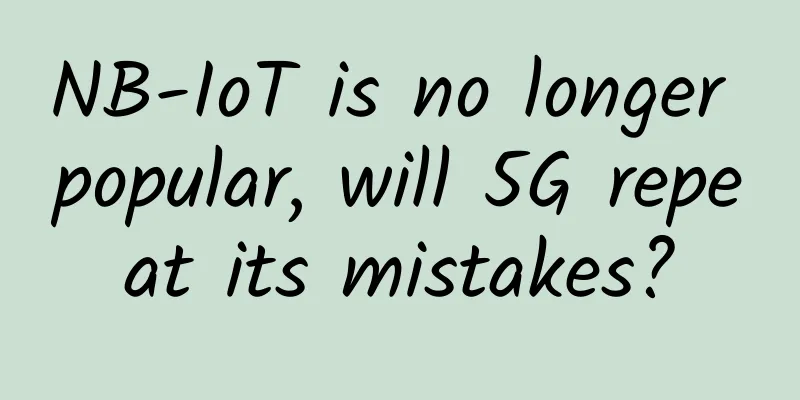NB-IoT is no longer popular, will 5G repeat its mistakes?

|
The current situation of NB-IoT (hereinafter referred to as NB) is very delicate. In the past few years, NB has been a well-deserved industry celebrity and has been highly sought after. The three major operators have been working hard to promote its commercialization, and the government has also issued various documents and policies to pave the way for it. Not to mention the equipment manufacturers, who have spared no effort to promote it. However, in just half a year, everything changed. People have shifted all their attention to 5G. All over the country, they are busy building 5G pilot projects, making 5G calls, and watching the ultra-high speed of 5G. The media is full of news about 5G, and no one mentions NB anymore. Today's NB has become a has-been internet celebrity.
Is NB's fall from favor a normal technological iteration? Is it reasonable? I don't think so. I think the industry should pay attention to the series of problems encountered in the process of NB promotion. Especially for 5G, the failure experience of NB has great reference value. The significance of NB is actually much greater than we imagined. In my opinion, it is the first cellular Internet of Things communication technology standard that can be produced, and it is also the first technical standard designed by the mobile communication camp specifically for entering the Internet of Things.
Before this, IoT = WLAN IoT (short-distance communication technologies such as WiFi, Bluetooth, and Zigbee). Today, IoT = WLAN IoT (WiFi, Bluetooth, Zigbee...) + cellular IoT (2/3/4G, NB, LoRa, eMTC, Sigfox...). LPWA: Low Power Wide Area As we all know, the Internet of Things is the main application direction of 5G, and 5G also belongs to cellular Internet of Things technology. Although 5G is very powerful, it is not a simple evolutionary replacement relationship with NB. We can think of NB technology as a simplified version of LTE technology. The NB network is a transformation of the existing LTE network. LTE network serves people, serves mobile phones, and serves consumer Internet. The NB network serves "things", serves IoT terminals, and serves the Industrial Internet (IoT). The characteristics of NB, in simple terms, are:
Four major characteristics of NB NB's own positioning is very clear, that is, low-power and wide-area coverage IoT scenarios, such as remote meter reading, environmental monitoring, and wildlife tracking. NB has some advantages that 5G does not have, so it cannot be quickly replaced by 5G: First, NB is an off-the-shelf technology that can be used at any time. The NB standard has been frozen for a long time, and 5G has only completed the eMBB standard. The uRLLC and mMTC related to the IoT scenarios will have to wait for more than a year and will not be completed until the end of 2020. Second, NB's network construction cost is lower. Because NB is based on LTE network technology, it can be quickly networked and coverage expanded by modifying the existing LTE network. Currently, major operators are still vigorously promoting the construction of LTE networks, which is also conducive to improving NB coverage. Third, it is the coverage distance. 5G’s coverage distance is a shortcoming. If the low-frequency band cannot be freed up for 5G use, 5G coverage will be a problem. From the current perspective, 5G will only cover hotspots in the next few years, and it is impossible to achieve the same coverage level as 4G across the country. The signal gain of NB is greater than that of LTE. If it is built carefully, it will definitely have advantages over 5G. Fourth, the cost of NB communication modules is lower than that of 5G (at least for a few years). Of course, 5G also has its own advantages over NB: One is large bandwidth and high speed. This is mainly used by mobile phones (consumer Internet). In the IoT scenario, the large bandwidth demand is concentrated in video backhaul (4K/8K) and VR/AR. This scenario is not common. NB's bandwidth is indeed very small, but eMTC can make up for this deficiency. eMTC is also modified based on LTE, a bit like a brother of NB. (For more information about eMTC, please see here: eMTC Internet of Things, what is the relationship with NB-IoT?) The second is low latency. At present, 5G has an obvious advantage in low latency. However, apart from the Internet of Vehicles, there are not many application scenarios for low latency in the Internet of Things. The third is the massive number of connections. For the Internet of Things, the 5G target is 1 million connections per square kilometer, and the NB target is 50,000 connections per cell. Currently, the application scenario of 1 million connections does not seem to have appeared. To summarize, as shown in the following figure: A simple comparison between NB and 5G As can be seen from the figure, NB and 5G are complementary. So, just like 5G cannot replace LTE, 5G cannot replace NB. The relationship between 5G and NB is more like the relationship between the main force and the vanguard. In our battle towards the "Internet of Everything", NB is an attempt. Unfortunately, NB failed in this attempt and encountered setbacks, which obviously cast a shadow on the future of 5G. In the past, when Wi-Fi and Bluetooth were in use, the Internet of Things was not popular, and we could say that the technology was flawed. Now, cellular Internet of Things technologies such as NB have been hyped for a long time but still cannot be implemented. So we really should think about the reasons. Is it the technology itself? Or is it the marketing? In other words, is the problem on the supply side (our communications industry) or the demand side (the user side)? Xiaozaojun once discussed this issue with a friend who works in an operator's IoT subsidiary. From the operator's internal perspective, he summarized several reasons:
I also conducted a survey with a friend who works on IoT products and asked him what he thought of NB. His answer to me was even simpler: first, the cost of NB terminal modules is higher, second, the usage fee of NB IoT cards is more expensive, and third, NB coverage is not good. Therefore, he would rather continue to use GSM (2G). I personally think that there are indeed many reasons why NB failed to succeed. From the perspective of NB itself, the indicators promoted in the early stage were indeed exaggerated. For example, the terminal power consumption was claimed to be 10 years of battery standby, but in reality it was far from being achieved. On the other hand, the coverage quality of NB network still has problems, which also leads to users' lack of confidence in it. There are also many problems at the non-technical level. As the main promoter of NB implementation in the industry, operators have more prominent problems. Operators have not performed well in market operations and solution implementation for government and enterprise users. An insider said that operators are not suitable for providing deep customization and refined services to corporate users. Another reason is that operators, enterprises and some government departments are too impetuous and attach too much importance to formalism when promoting the implementation of NB technology. In summary, exaggerated performance indicators, poor network coverage, problems with the business model, and an impetuous mentality are the main reasons for NB's setbacks. So, does the 5G that we are vigorously promoting now also have these problems? I believe everyone should have the idea in their mind. Take the impetuous mentality as an example. Now there are news about 5G in various places every day, such as "5G train station", "5G airport", "5G smart city", "5G court", and "5G remote surgery". Isn't it very similar to the previous NB hype? Many so-called "5G pilot projects" and "5G solutions implementation" are just for show. They take some photos, write some promotional articles, and then are left alone, gathering dust. If we don’t learn from NB’s failure, there is a real possibility that 5G will repeat the same mistake. If 5G wants to succeed, the difficulties it faces are far greater than imagined. The development process of modern communications is actually a process in which the supply side constantly catches up with the demand side. In the 1G, 2G, and 3G eras, the communication infrastructure was too backward and humanity’s demand for communication was very urgent, which stimulated the rapid development of communication technology. The supply side continued to improve and ultimately met the demand side. In today's 4G era, the demand side and the supply side are in a delicate balance. If the demand side does not move forward, it will be difficult to simply push the supply side forward. Unlike 1/2/3/4G and other networking technologies, 5G directly opens up a new battlefield. Its main goal is to open up the era of the Internet of Everything and to find and meet the needs of the Internet of Things. At present, the demand definitely exists, but it takes more time to find and cultivate. Regardless of whether it is equipment manufacturers or operators, enterprises or governments, no one has the ability to significantly shorten this time. In the face of this long waiting period, instead of engaging in "campaign"-style promotion and forcing things to grow, it is better to adjust the mentality and patiently do basic work such as industrial chain support, management optimization, core technology research and development, product polishing, talent training, and network infrastructure construction. This will be more meaningful. In short, 5G is not a 100-meter sprint. It is a marathon, and the one with the most patience will have the last laugh. |
<<: A collection of network failure and cause analysis (with solutions included)
>>: Everyone says China is strong in 5G, but what makes it so strong? Why is it so strong?
Recommend
How can operators break the curse of the “scissors gap” between volume and revenue?
[[180644]] The "Economic Operation of the Co...
From telegraph to 5G, 7 changes in the 60-year history of mobile communications
The history of communication has been around for ...
Ministry of Industry and Information Technology: More than 600,000 new 5G base stations will be built in 2020
According to statistics from the Ministry of Indu...
WOT2018 Xian Yunsen: Algorithms are everywhere in O2O search
[51CTO.com original article] Seven years of hard ...
How much do you know about the unlimited traffic trap?
Nowadays, many elderly people use smartphones. Sm...
SmartHost newly launched VPS distribution starting from $6.95/month, multiple data centers available
I received an email from SmartHost, informing me ...
CloudCone: $16.3/year-1GB/55GB/3TB@1Gbps/Los Angeles data center
CloudCone has released several Easter packages, w...
Everything you need to know about Wi-Fi 7
Over the past few decades, Wi-Fi has become the w...
Five communication methods between processes required for interviews
Inter-Process Communication (IPC) refers to the t...
iWebFusion: $99/month - Dual E5-2670, 128G memory, 500G SSD hard drive, 20TB monthly traffic, 5 data centers including Los Angeles
I have shared iWebFusion many times in my blog. I...
H3C: The key to computing-network integration lies in the efficient coordination of computing power and transportation capacity
On September 26, the "2022 China Cloud Netwo...
6 places that provide free certificates to upgrade your website to HTTPS for free
As websites such as Google, Taobao, and Baidu hav...
What is the Information and Communication Service Perception Enhancement Action? Here comes the interpretation from the Ministry of Industry and Information Technology!
According to the website of the Ministry of Indus...
Talk about IPv6 and Happy Eyeballs
[[256713]] Let's look at a picture first. Fro...
Borui Data: Service-accessible data chain DNA
Today, those born after 1995 have gradually becom...





![[11.11] LOCVPS: 30% off on all VPSs/50% off on some VPSs, 50 yuan bonus for 300 yuan top-up, KVM/XEN multiple computer rooms available](/upload/images/67cac23c1c8be.webp)



